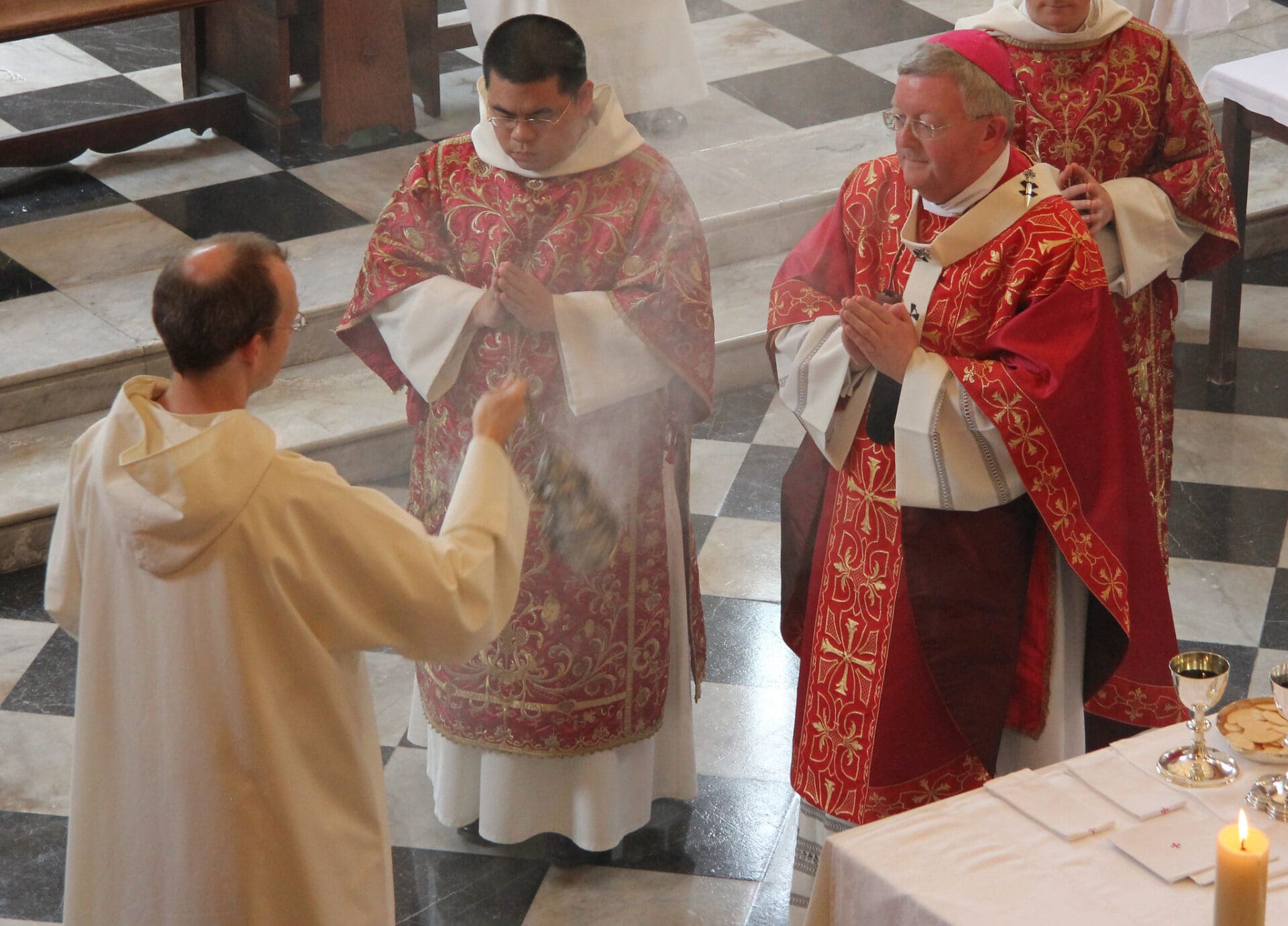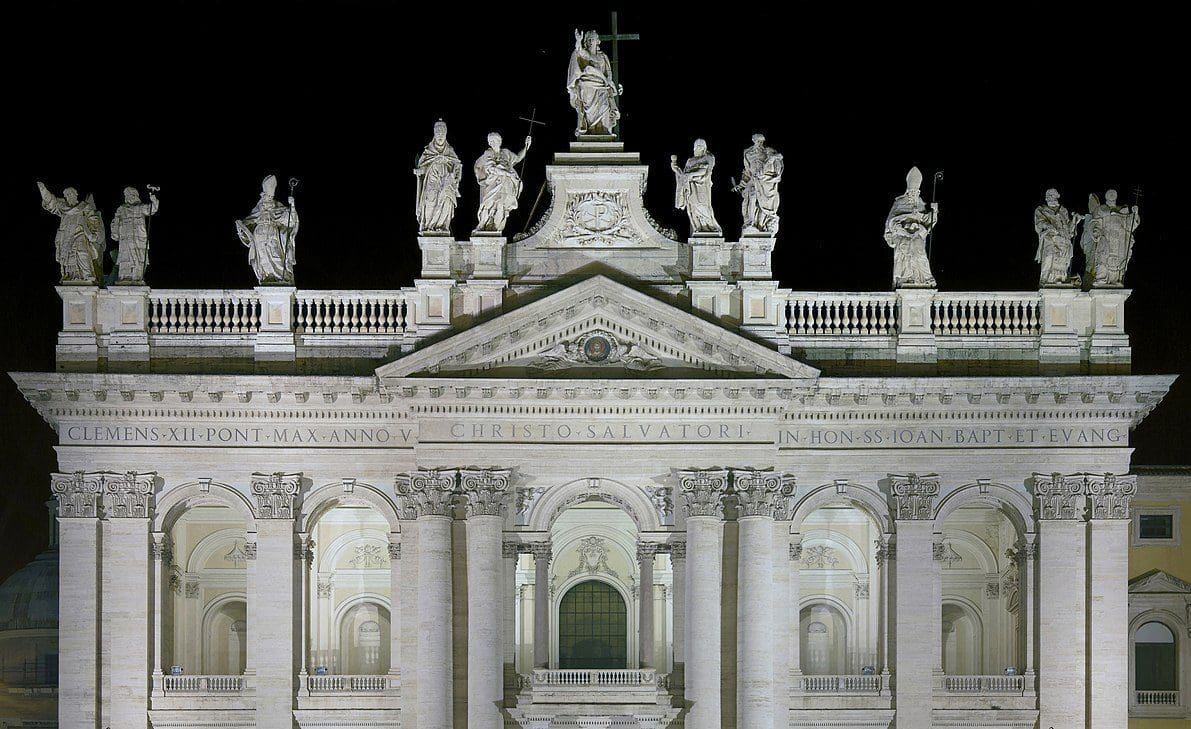Online Edition – Vol. IV, No. 5: September 1998
As a candidate for the seminary in the early 1980s, I once faced about twelve priests, religious and laymen who screened candidates for a major Midwestern seminary.
During the interviews, one priest wanted to know how I would “feel” if priest faculty members would celebrate Mass on the grounds without vestments. I responded that I understood that wouldn’t be correct. Canon law confirms my initial reaction: “In celebrating the Eucharist, priests and deacons are to wear the liturgical vestments prescribed by the rubrics”, C. 929.)
But the priest insisted that I express my feelings. The question was beside the point; feelings have little to do with one’s resolve to celebrate Mass according to the mind of the Church. (Many priests do not “feel good” about poor translations of the Mass, but use them anyway.)
Eventually I gave in: I said that I wouldn’t “feel good” about it.
Within the month, I learned that I was denied admission because the seminary authorities determined that I was “rigid and judgmental”.
Years later, I would be ordained to the priesthood in another diocese after completing my studies and formation in a kinder, saner seminary. I remember saying to my first pastor that, if I had an “agenda”, it was to celebrate Mass according to the liturgical legislation of the Church as documented in the General Instruction on the Roman Missal (GIRM). It didn’t occur to me until a few years later how truly radical — even allegedly “pre-Vatican II” — such an agenda would be thought to be.
After ordination, when I would return to my hometown, my parents didn’t understand why I chose to celebrate Mass at home rather than to concelebrate at the local Catholic church. But there were good reasons for my decision.
Years before, at a seminarians’ retreat in my home diocese, I was asked to be a lector at Mass. A transitional deacon carefully explained that I should change the official texts for “inclusive language” purposes. When I politely declined, claiming that I did not have the authority to do so, he sternly suggested that I discuss the issue with my formation director. I didn’t.
But I soon became aware of the extent of liturgical abuse in the diocese. For example, I knew it was a pervasive practice to violate the rubrics by such things as routinely bowing (not genuflecting) after the Consecration and omitting the lavabo (washing of the hands) during the Offertory.
Had I celebrated Mass according to the rubrics during my home visits, it would have been a novel experience for many parishioners. Most were simply not aware that many of the changes and omissions that had become institutionalized were actually liturgical abuses. If I were to insist upon celebrating Mass correctly, the people might be confused.
Like many priests, I avoid the problem and choose to celebrate “Mass without a congregation” when on vacation.
However, when a close relative died and I returned home to celebrate a funeral Mass, I assumed that, as the main celebrant of an unscheduled Mass, I would be able to celebrate the Mass according to the rules of the Church. I had no reason to fear a liturgical ambush.
In a phone conversation, the pastor invited me to the parish to “discuss the liturgy”. I said that I didn’t think it was necessary, that I’d just “plug into the system” upon my arrival. Any experienced priest, I thought, can navigate the variations in church floor plans.
Shortly before Mass began, I noticed that there would be no paten; that the ciborium (the sacred vessel holding the hosts) would be a basket lined with a corporalhardly the “solid” and “noble” material to contain the Body of Christ called for by the General Instruction (GIRM 290).
When the pastor and I vested, I was given a polyester chasuble, the liturgical equivalent of a leisure suit. It was soiled and oversized in every area, especially around the arms (experienced priests will know what I’m talking about).
The pastor suggested I wear the overlay stole. But the stole, a sign of priestly authority, is to be worn under the chasuble. The authority of the priest, symbolized by the stole, is subsumed by the authority of Christ, symbolized by the chasuble. That is why official church documents require that “…the chasuble [should be] worn over the alb and stole…” (GIRM 299). So I casually remarked that “it’s really no big deal”; I would wear the stole under the chasuble.
We processed to the altar to begin the funeral ceremony. The tabernacle was slightly off to the side, so I genuflected in the direction of the Blessed Sacrament. The pastor merely bowed, in violation of liturgical legislation: “On reaching the altar, the priest and ministers make the proper reverence, that is, a low bow or, if there is a tabernacle containing the Blessed Sacrament, a genuflection” (GIRM 84).
My homily was about twelve minutes long, a little longer than usual. (The deceased, after all, was a relative.) But despite my affection for my relative, I was careful to honor Church law: “At the funeral Mass there should as a rule be a short homily, but never a eulogy of any kind” (GIRM 338).
I am also careful not to canonize the deceased. While it is a natural sentiment to think of deceased loved ones in heaven, it is presumptuous to assume they avoided purgatory. What is the main purpose of a funeral if not to pray for the repose of the soul of the deceased?
Without eulogizing my relative, I used some of his well-known attributes to lead into a commentary on the Gospel. I concluded with an appeal to Catholics to avoid “presuming the mercy of God” and to “renew the covenant” with God every time Sunday Mass is celebrated. I made a gentle if unambiguous appeal to the congregation to come to Mass on Sunday. (I attached no special importance to the pastor’s restlessness, which I couldn’t help noticing during my homily.)
During the Offertory, I received the gifts of bread and wine, pronounced the requisite prayers, and turned to the sacristan-server for the washing of the hands as required: “The priest then washes his hands as an expression of his desire to be cleansed within” (GIRM 52).
The server looked confused. I took a cruet with water, washed my finger tips, and said in a low voice, “Lord, wash away my iniquity, cleanse me from my sins.”
The Offertory concluded with the Prayer Over the Gifts, preceded by the response, “May the Lord accept the sacrifice at your (i.e., the priest’s) hands.” The pastor at my side led the congregation in saying in a loud voice, “May the Lord accept the sacrifice at our hands”. This blurred the distinction between people and priest.
It isn’t unusual for Catholics to be confused at funerals. Emotions, and the legitimate variations in the ritual add to this confusion. At times, the congregation needs to be reminded to stand, kneel, etc.
This funeral was no exception. But after the Sanctus, my instruction to the people to kneel was met with confusion and delay.
According to the General Instruction, “…the people kneel beginning after the singing or recitation of the Sanctus until after the Amen of the Eucharistic prayer, that is, before the Lord’s Prayer” (GIRM, Appendix 21).
Apparently my instruction contradicted a local custom that is, I had inadvertently drawn attention to a common liturgical abuse: standing during the Eucharistic Prayer.
I consecrated a carafe of wine placed on the altar during the Offertory by the sacristan-server. The Precious Blood would be distributed by the extraordinary ministers of the Eucharist using ordinary wine glasses which, to my mind, stretches the General Instruction which states that containers for the consecrated elements are to be made of “noble” materials that “do not break easily or become unusable” (GIRM 290). However, the use of wine glasses has become so common that it is almost impossible for a visiting priest to suggest a change.
After Communion, I consumed the Precious Blood from the principal chalice. But, to my surprise, I saw that there were two wine glasses containing a substantial amount of the Precious Blood remaining on the credence table behind the altar.
I decided to wait until after Mass and ask the help of practicing Catholics to help consume the remaining elements. The General Instruction says, “It is also permitted, especially if there are several vessels to be purified, to leave them, properly covered and on a corporal, either at the altar or at a side table and to purify them after Mass when the people have left” (GIRM 120).
Meanwhile, the pastor began a ten-minute talk. It seemed clear he wanted to convey a “pastoral sensitivity” toward the deceased he thought absent from my homily. Although his knowledge of the deceased was superficial (he mispronounced the spouse’s name), he repeatedly referred to a foible of my relative’s.
After the closing prayers and procession, I hastened back to the altar with a practicing Catholic to help with the consumption of the Precious Blood.
Too late. The sacristan had already poured the consecrated wine down the sacrarium, spattering the side of the sink.
Sensing my disapproval, he sheepishly said that he was told to do it that way. I realized that the poor man was as much a vicitm of liturgical tyranny as I was.
The distractions made it almost impossible for me to pray during the Mass. The experience made me resolve to return to my practice of celebrating “Mass without a congregation” during my future visits home.
The purpose of liturgical legislation is not to encourage “rigid rubricism” (that would be difficult, anyway, given the number of options permitted by the GIRM); it is to promote the noble goal of reverence and unity in Catholic worship.
The rich theology of the Mass, unfolding in ritual over the centuries, becomes intelligible, both to young priests and to parishioners, gradually; by a familiarity that comes with repetition and with careful and consistent observance of the liturgical norms. If this is neglected, if the norms are ignored, a powerful means of transmitting the Church’s teaching about the meaning of the Mass is lost.
This is why the Second Vatican Council teaches that “there must be no innovations unless the good of the Church genuinely and certainly requires them, and care must be taken that any new forms adopted should in some way grow organically from forms already existing” (Sacrosanctum concilium 23).
Father Jerry Pokorsky is associate pastor of Holy Spirit Church in Arlington, a founder of CREDO, and a member of the Executive Committee of Adoremus.


